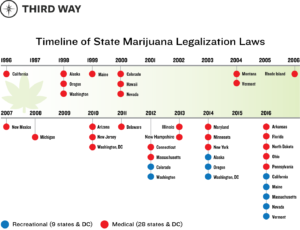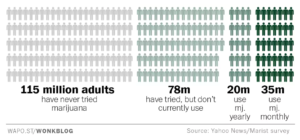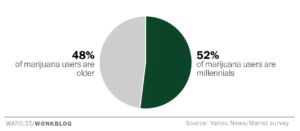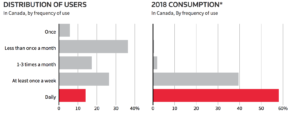By Roy Pankey
Marijuana is everywhere. That has been true for a long time, but it has become vastly more visible in the last several years. For decades, marijuana users depended on the black market alone to get their hands on the drug. Things changed in 2012 when Colorado voters passed a ballot initiative to legalize cannabis. California is among the nine states (and the District of Columbia) that have followed the Centennial State’s move. More than 65 million Americans now live in states permitting adults to legally consume marijuana for any reason. Legalization advocates argue that regulating cannabis brings the industry into the light where governments can tax pot and effectively eradicate the black market.
Governor Jerry Brown’s administration estimated $175 million in cannabis tax revenue for the first half of 2018, but the Legislative Analyst’s Office reported revenue of just $34 million in the first quarter, a figure about 80 percent below projections. Why was Brown’s estimate so far off? It isn’t because Californians don’t like weed; legalization doesn’t hinder the black market. In some ways, it aids illicit trade. Though the plant is legal in several states, the marijuana black market has not taken a hit. The legalization of cannabis acts as a shield against suspicions of impropriety, disguising illegal growers as legitimate, enticing sellers to avoid regulation, and dissuading buyers from making regulated purchases. Let’s look at how this works.
The majority of cannabis touches many hands before consumption. The grower plays the inaugural role in the distribution channel. As soon as marijuana is legalized in a jurisdiction, many farms appear after receiving a grower’s license. The sight of marijuana growing operations becomes commonplace, and no one questions the legitimacy of the cultivation. It is at this point, when everyone assumes all growers in the region are licensed, that unlicensed growers establish farms. They hide their illegal setup behind the public’s complacency and are not questioned about their work. NPR reported on an example of this kind of illegal pot farm in Okanogan County, Washington and how it was busted by local authorities. The growers of this farm went as far as trying to dupe their tax assessor. Owners filed to pay agricultural property taxes at the exact rate for licensed cannabis farmers. While unlicensed growers inherently supply the black market, even legal growers find opportunities to contribute to the trade.
Authorities in California fight illegal cannabis. (BBC)
Regulation in this business depends on licensed farmers to be forthcoming with their production numbers. Without a way to ensure honesty, some legitimate pot producers take advantage of the system. Growers are required to tag their plants and disclose the number of buds harvested from each plant. Authorities have recognized that farmers often “set aside” buds without counting them. Fraudulent bud counts routinely go unnoticed, as the amount of product a given marijuana plant yields is contingent on several factors, including the amounts of water and sunlight the plant received, whether or not it was treated with fertilizer, the climate in which the plant grows, and more. This unaccounted cannabis automatically becomes part of the black market.
Sellers are the next hands in the supply chain and the next to subject themselves to the same kind of criminal activity in attempt to evade the obtrusive restrictions on marijuana vending and marketing. Before a seller can put their products up for sale, they need a license. Obtaining a license can be an arduous process. In the weeks leading up to California’s legalization of pot, Los Angeles only employed four full-time regulators to sift through licensed seller applications. The lack of staff caused a backlog in application reviews and left countless growers, businesses, and hopeful entrepreneurs in a state of uncertainty, according to Pot Network. Many of the candidates were bogged down by expensive leases and other costs without generating any income, making the prospect of selling marijuana illegally attractive. But people in other cities in California might have considered these fretting applicants lucky.
Sellers in some cities were especially prone to get involved in the black market, because individual California cities were allowed to prohibit any and all legal pot businesses if they want. Many had chosen to do just that. The LA Times reports that about half of Californians reside in cities that banned dispensaries and pot delivery services. There is no doubt that a ban of this magnitude played a role in the state’s sending of more than 2,500 cease-and-desist letters to unlawful marijuana shops as of August. In July, the state’s Bureau of Cannabis Control clarified the law, saying pot delivery companies could deliver to any private address in the state. Deliveries can now be made in any city, whether a city holds to its dispensary ban or not. The bureau hopes to made marijuana accessible to all adults in California regardless of where they live. Employees of delivery businesses still must verify the buyer’s identity and age, another potential deterrent for selling legally.
Weed’s wide fanbase tempts sellers to ignore current legal limitations on who they can take money from. All states that have legalized recreational marijuana mandate buyers be at least 21 years old. The Washington Post reported that 52 percent of users are millennials. While most millennials are now 21 and over, the study found that marijuana use is skewed significantly toward a younger demographic. The report also showed that nearly 55 million Americans currently consume cannabis, while 35 million consume it monthly.
This means that a very large number of young people in this country are using the drug. As young Americans—potentially too young to be legal consumers—represent such a large chunk of the pot market, some sellers disregard the law and sell to those under age.
A buyer’s age isn’t the only thing some sellers overlook. In states that allow cannabis for medicinal purposes, some sellers aren’t concerned by whether or not their clients possess the proper licenses for consumption. Currently, it’s legal to smoke marijuana for medical use in 20 states. Medical marijuana refers to the use of cannabis as a doctor-recommended form of medicine or herbal healing. Most states that permit medical pot require patients to hold a medical marijuana card, a license that allows you to smoke pot.
California allowed medical cannabis before it legalized the drug for recreational use. The state’s Medical Marijuana Identification Card Program (MMICP) created a legal license for consuming marijuana and a database used to verify qualified patients and their primary physicians. Last year, getting your license from MMICP was rather easy; any doctor licensed in California could write a recommendation for medical cannabis, and the patient simply had to take the paper to a dispensary. You could even complete the process with an app without ever leaving your house. (Since January 2018, both MMICP and the app have become obsolete.) In states that still require a medical marijuana card, sellers avoid the hassle of asking to see a buyer’s card and verifying their enrollment in the state’s medical use database. All sales finalized without appropriate certification become sales in the marijuana black market. Similar to sellers, buyers participate in the black market to achieve less stressful transactions.
Many buyers turn to illegal pot for the same reasons sellers do, such as for being under age and not holding a valid consumption license (where applicable). Other reasons include lower prices, convenience of the sale, and the guarantee of anonymity. Prices are arguably the biggest reason some people choose to buy weed from the black market. “Sin taxes” on goods such as alcohol, tobacco, and cannabis are notoriously high. These high rates steer buyers toward cheaper options. Washington state levies a whopping 37 percent sales tax on pot purchases, while Alaska’s government nets $50 for every ounce sold. Reuters reports that while daily users in Canada make up less than 15 percent of marijuana users, they account for nearly 60 percent of the country’s total cannabis consumption.
Convenience is another factor that plays into the business of the black market. Not all communities have dispensaries, and some people have to drive lengthy distances to purchase marijuana from the nearest retail store. Buying from unlicensed sellers in these communities is often much easier than the alternative. The avoidance of purchase limits also falls under the convenience umbrella. In some instances, dispensaries must limit your purchase to a particular amount of legal marijuana. With black market dealers, such restrictions don’t exist. Before finalizing a legal sale, the buyer must present a photo I.D. for age verification purposes. This requirement may disqualify those who don’t have a valid form of I.D. due to legal resident status or other reasons. The black market is also attractive to those who wish their favorite habit remain a secret. Sales of illegal pot are executed with far fewer eyes on the sale than regulated sales. If you’re buying illegal pot, you don’t have to worry about being seen in a dispensary by anyone you know or the knowledge of your sale being used in official sales numbers. Black market purchases can be made in cash without leaving a paper or legal trail.
Though recreational cannabis is legal is more states than ever before, the black market for the drug is showing no signs of stopping anytime soon. Illegal growers blend in with legal growers. Legal growers smuggle to states where it’s illegal to sell. Sellers don’t want to spend time trying to verify a buyer’s age and eligibility to consume. Buyers don’t want to pay high taxes on their weed. Roll and repeat.
Sources:
BBC, https://www.youtube.com/watch?v=59w-HQq2x0o
Bureau of Cannabis Control, https://cannabis.ca.gov/wp-content/uploads/sites/13/2018/07/Bureau-of-Cannabis-Control-Proposed-Text-of-Regulations.pdf
CBS Los Angeles, https://losangeles.cbslocal.com/2014/04/30/costa-mesa-man-gets-3-years-for-furnishing-pot-laced-brownies-to-minors/
EazeMD, https://www.eaze.md/
LA Times, http://www.latimes.com/opinion/editorials/la-ed-marijuana-delivery-20180814-story.html
Legislative Analyst’s Office, https://lao.ca.gov/LAOEconTax/Article/Detail/282
Pot Network, https://www.potnetwork.com/news/why-marijuana-legalization-belongs-californias-black-market
Tax Foundation, https://taxfoundation.org/state-marijuana-taxes-2018/
Third Way, https://www.thirdway.org/infographic/timeline-of-state-marijuana-legalization-laws
Washington Post, https://www.washingtonpost.com/news/wonk/wp/2017/04/19/11-charts-that-show-marijuana-has-truly-gone-mainstream/?utm_term=.388a41fe4ac5



